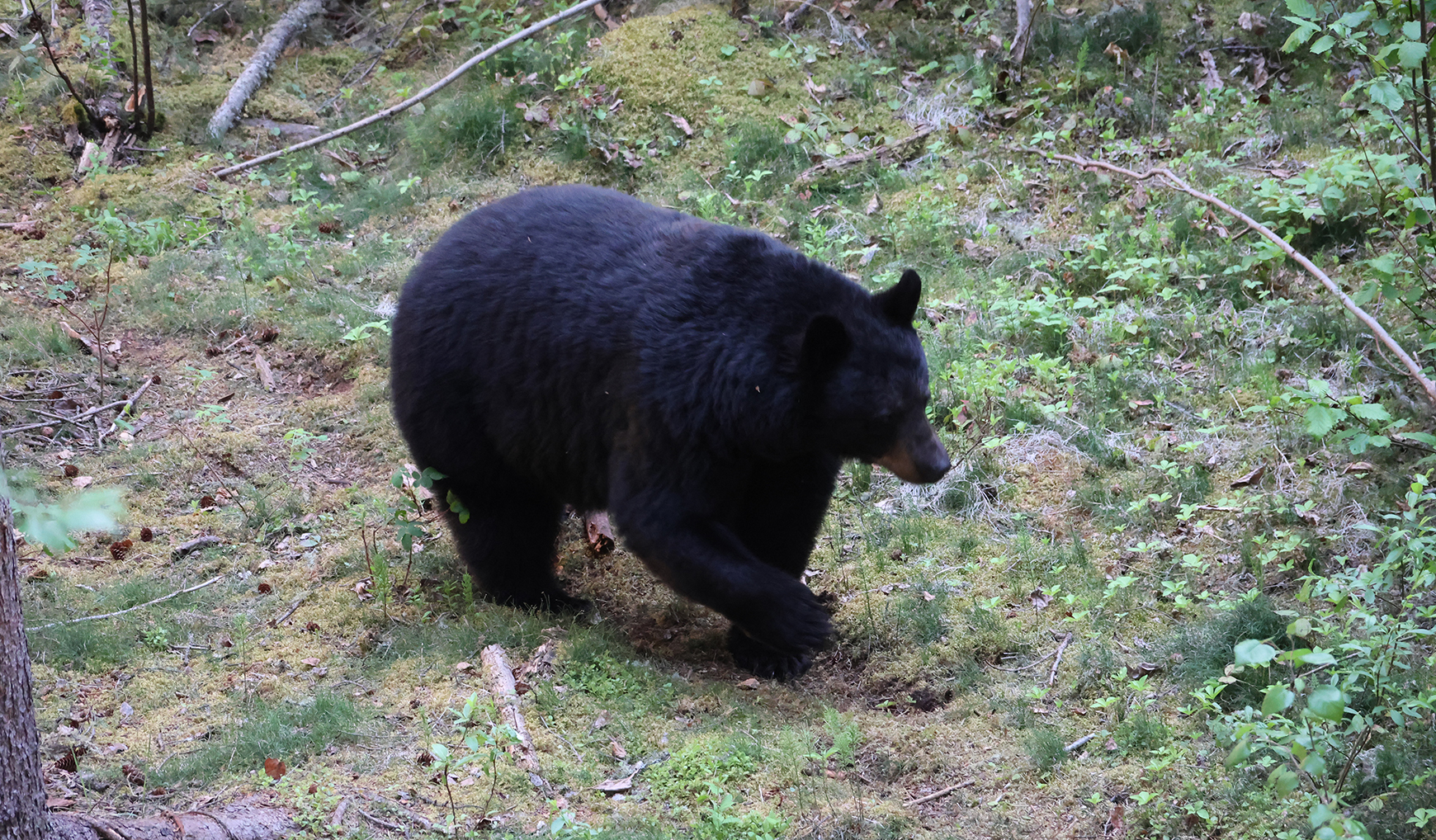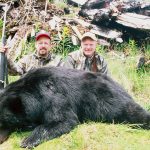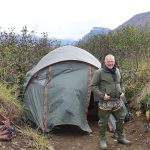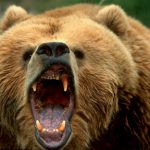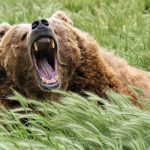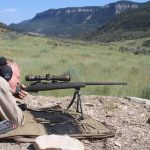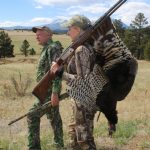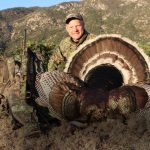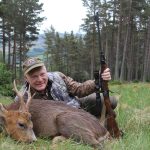Black bear hunting is available, affordable, and typically successful. But bears are tough to judge!
Photo above: This bear has all the hallmarks of a big boy: The head appears small, legs seem short, body is ponderous, ears seem wide apart on the skull.
For many hunters, spring is about turkeys. And as I wrote last month, for European hunters, spring is about roebuck. For me, though, spring is about bear hunting. Primarily black bear hunting, because the hunts are widely available, affordable, and highly successful. Early in spring, only the big boars are out of their dens. Now, in June, they’re all out. This time of year, we have to be careful to watch for sows with cubs, which may be hidden back in the brush a bit. But the advantage of hunting in June is that the boars are getting amorous.
This is the first spring in several that I haven’t gone black bear hunting. I’m missing it, but don’t feel sorry for me; I’m in Alaska looking for a big brown bear. Honestly, I have no great reason or excuse to take another bear of any kind. But I like bear hunting; it is interesting and exciting. I expect this to be my last hunt for a brown bear, but I’ll do more black bear hunting. What’s not to like about a hunt that is so available, affordable, and typically successful?
Everybody wants a big bear, of course. And everybody wants a beautiful bear. June is a great time to hunt, but the older boars have been out for a while. Especially if the weather is warm, some hides are rubbed. This is not always easy to see, especially in poor light; you just have to look as close as you can. If the fur looks patchy and thin, it may be a giant bear, but it may make a poor rug.
Personally, I like black bears that are black. Maybe this is because I’ve shot brown and cinnamon-colored black bears. Maybe it’s because I’ve shot brown/grizzly bears that are anything except black. I don’t know; to each his/her own. The various color phases of black bears are exceptionally beautiful, and many bear hunters are crazy for them. However, you can hunt black bears for size or color, but it’s difficult to do both with equal results.
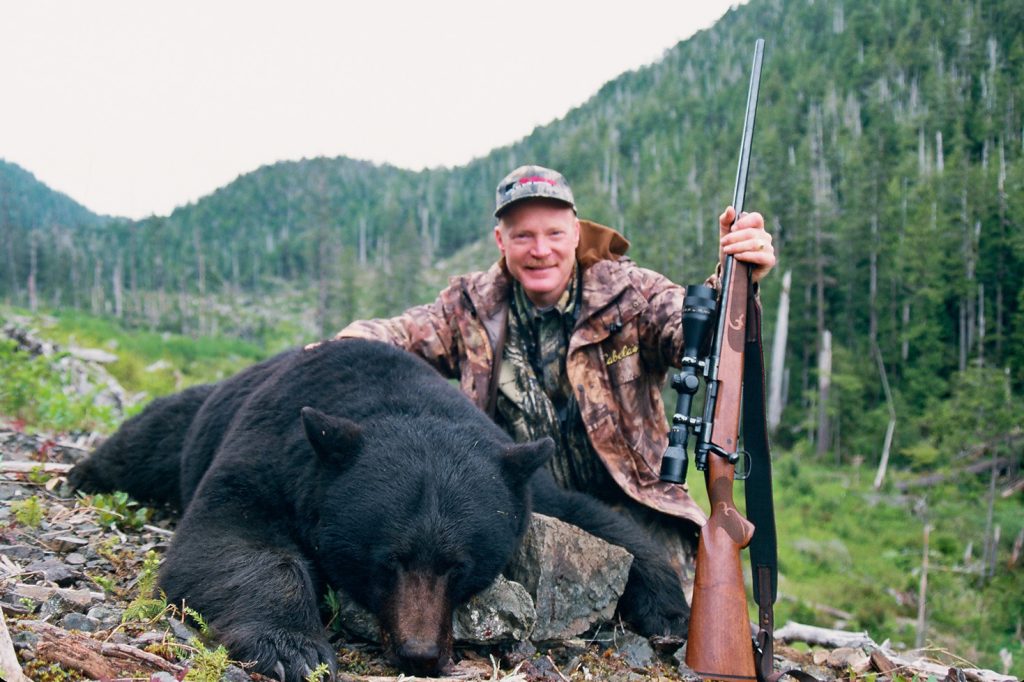
In a perfect world, I like two-bear areas. With black bears, unlike most North American big game, there are lots of multiple-bear areas, including parts of Alaska, several Canadian provinces, and northern Idaho. I’ve been skunked many times on hunts when I would have been delighted with one chance at one bear. But let’s enjoy our perfect world: For many, a perfect black bear hunt would be to take one big black bear, plus a pretty, color-phase bear.
I shot my first black bear in Montana in the spring of 1973; it happened to be a beautiful, brown-colored bear. Since then, I’ve taken two bears in two-bear areas, one bear in one-bear areas, one bear in two-bear areas, and no bears at all in both one and two-bear areas. All multiple times. I don’t go every spring, but I like black bear hunting. But in fifty years of black bear hunting, exactly once have I taken a black-colored black bear and a color-phase black bear on the same hunt. That was with Trapper Don McRae in northern Manitoba, some forty years ago.
My young Kansas friend Michael Persinger, cousin to my neighbor and whitetail partner Chuck Herbel, was recently headed to Alberta on his first black bear hunt and first-ever guided hunt. He was apprehensive; nervous about hunting with a guide, nervous about bears. Understand, Kansans don’t live with bears; all we know about bears is the scary horse-pucky. Well, he had his Dad’s Remington M700 .30-06, won in a raffle in 1985. His Dad wasn’t a hunter, so it was still a new gun, broken in on Michael’s first Kansas buck. The .30-06 is not a big gun, but it’s plenty for any black bear that walks, especially when hunting over bait, where shots will be close.
So he was well-armed, and headed to a good two-bear area, hunting with Red Willow Outfitters in central Alberta. He told his guide, Taylor, “I really hope to get a color-phase bear and a big black bear.” Well, who doesn’t? The outfit must know what they’re doing, because Michael’s black bear measured 7 feet 4 inches, an awesome bear with a big skull.
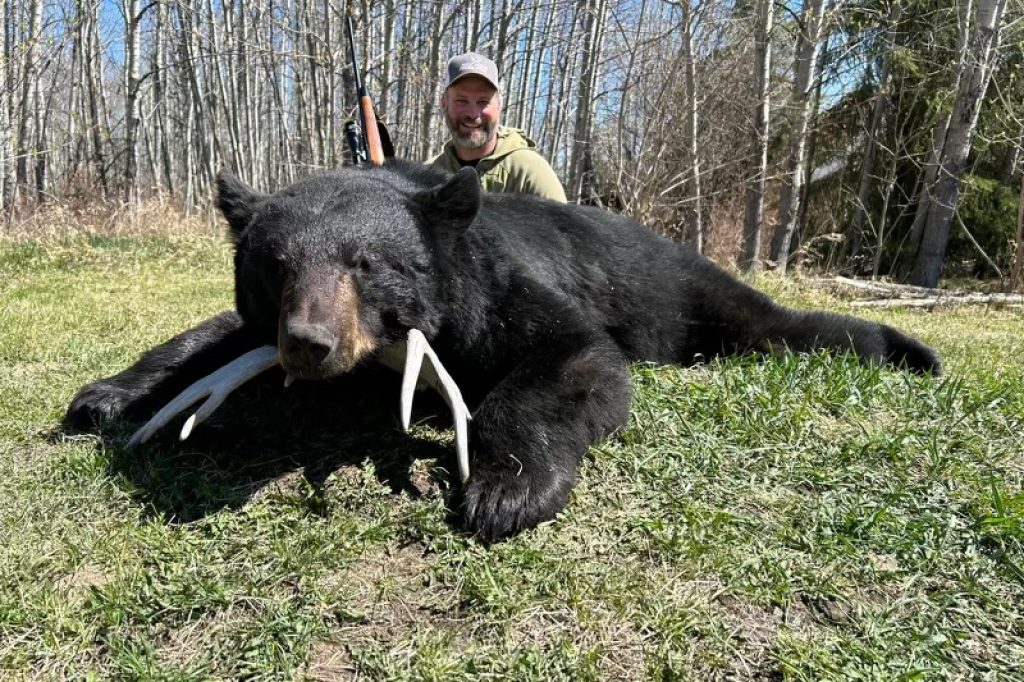
Then he took a beautiful, red-colored bear, not a small one. He might do a lot of black bear hunts in a lot of places and not do that again.
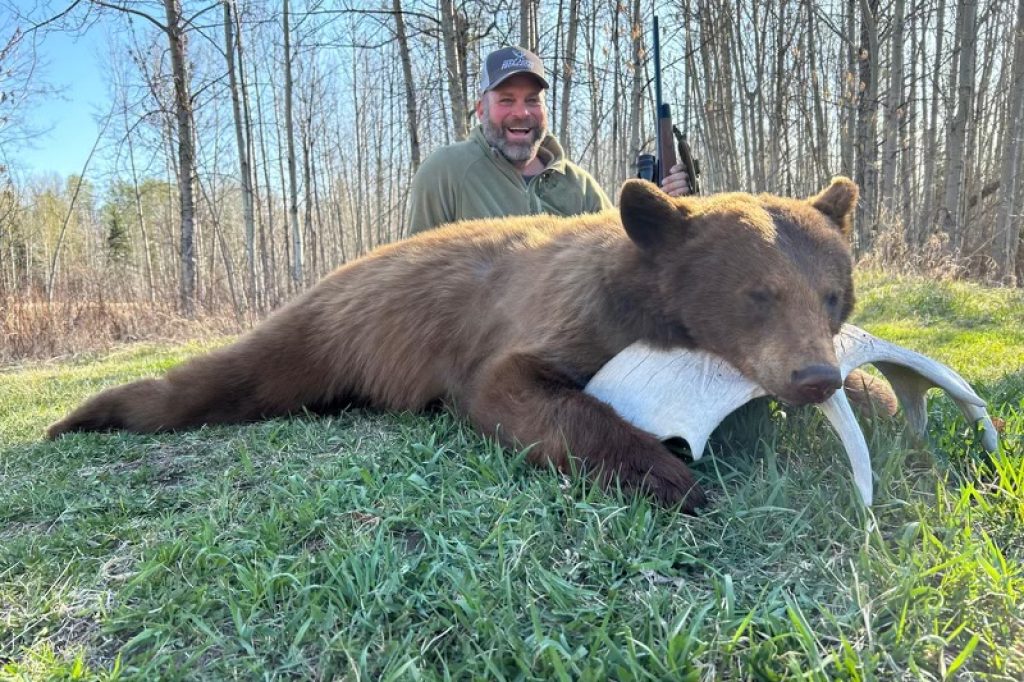
Big black bears are difficult. They exist wherever black bears occur (which is now almost continent-wide) but the biggest problem is to judge them. Even after fifty years, knowing full well what a big bear looks like, I still make mistakes. We’ll come back to that. Color phases are perhaps even more difficult than big bears.
Black bears occur in a wide color spectrum. Brown, blond, tan, red, and cinnamon bears probably occur almost anywhere black bears exist. The white (also called Kermode or “spirit”) black bear is mostly confined to the Queen Charlotte Islands. The “glacier,” or blue-gray, color phase occurs rarely in the Yakutat area of southeast Alaska, and is almost unknown elsewhere.
The tan-red-brown phases are common in some areas, rare in others. Central Alberta, where Red Willow operates, has a high percentage of color-phase bears. Color-phase bears are plentiful in much of the Rocky Mountain West, on up into central Canada. But, glacier bears aside, color-phase black bears are rare in Alaska. They are not uncommon in British Columbia, but scarce on Vancouver Island. It’s spotty. Because I prefer black-colored black bears, I don’t know enough to suggest where color phases are common, or where they are unicorns. I do know the odds are better in some places than others.
In 2022 and 2023, I hunted in extreme northern Alberta, right on the NWT line, with Wally and Louisa Mack’s WL Guide Service. The hunt used a similar methodology to what Michael described: Bait barrels to judge size, stands set close to baits for dual archery/rifle use. Both years I hunted there, most hunters took two bears. I took two nice bears both years. I was part of a group, other parties overlapping, so in twenty days in Wally’s camp I saw thirty bears come into the skinning shed. Every single one was coal black! So that’s not the place to look for a color phase, although they take them occasionally and have seen them on trail cameras.
The other thing about color-phase bears that must be understood: They are usually not the biggest bears. There are exceptions, but there is radio-collar evidence that color-phase bears sometimes turn darker (black) at full maturity. Now, the North American black bear population runs into the low millions. Hunting pressure is generally light, and the bears are a major nuisance in some areas. So there are sound management reasons why seasons are long with multiple-bear options; and why, typically, any bear without a cub is legal game. Don’t second-guess it to death, just accept that color-phase bears are beautiful, but usually, they’re not huge.
It’s okay if you get carried away by the color, and there may even be an optical illusion at play: Light-colored bears look bigger. But all bears are difficult to judge. If you see a bear on a hillside, and then you see a basketball-sized black object beside her, that’s easy: it’s a sow with cub, so quit looking. See any lone bear on a hillside, though, and it’s tough. Sure, there are signs: Ears seeming wide apart on the skull, short legs compared to the body, small head compared to the body, ponderous gait, broad chest. All of that, and it’s still easy to get fooled.
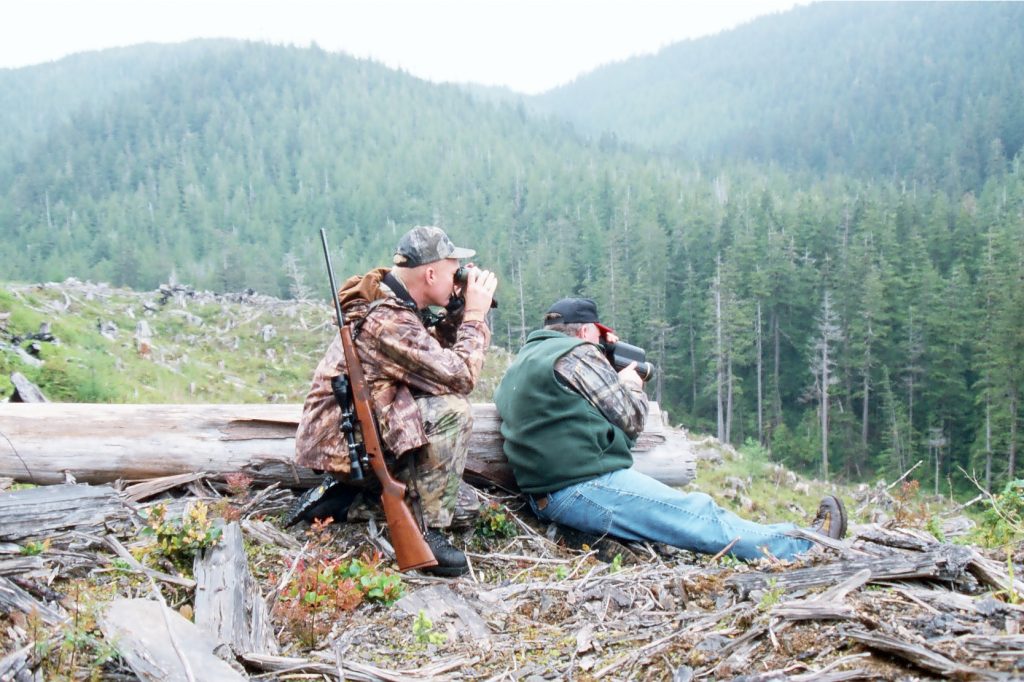
The two most selective methods for hunting black bear are over bait, and with dogs. The former works because the bait barrel is the yardstick, or because actual yardsticks have been set near the bait. The latter works because the encounter is too close for error, and because the track has been seen before the dogs are released.
Otherwise, judging bears is an imprecise science. Guides and outfitters who take more bears in a season than most will in a lifetime have an edge; we amateurs cannot compete. However, judging a lone bear on a hillside is always fraught with risk. Absent a cub, it will be legal to take, but often it is not the bear you think it is. Even after fifty years of hunting black bears, I can say this: they all look big when you first see them.

